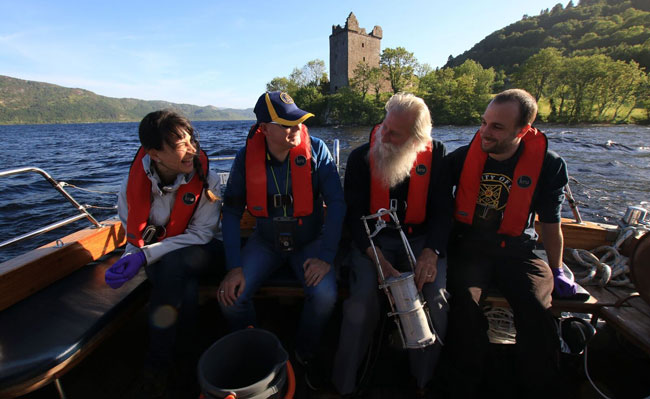 Thursday 28 June 2018 12:05pm
Thursday 28 June 2018 12:05pm
Science in spectacular surrounds . . . Members of the Loch Ness eDNA research project taking a moment in front of Urquhart Castle are (from left) Cristina Di Muri, University of Hull PhD candidate, Professor Neil Gemmell, of Otago, Adrian Shine, of the Loch Ness Project, and Gert-Jan Jeunen, Otago PhD candidate. Photo: Kieran Hennigan
The world is one step closer to finding out what lurks in the murky waters of Loch Ness.
Professor Neil Gemmell, of the University of Otago, and the Super Natural History environmental DNA (e-DNA) team has completed the first stage in their project to document life in Loch Ness, having successfully gathered 259 water samples earlier this month.
The samples are now being extracted at the University of Hull before going to Laboratoire D'Ecologie Alpine in Grenoble for metabarcoding and then sequencing in July and August.
From there, the sequence data will be sent to labs in Canberra, Copenhagen, Grenoble, Santa Cruz, Inverness, Hull, Baltimore and Dunedin where the gene sequences will be analysed and compared to samples stored on international DNA databases to identify each species present in the loch.
Professor Gemmell and colleagues from Otago, the Loch Ness Centre and Loch Ness Project, the University of Copenhagen, the University of Hull, and the University of the Highlands and Islands, were on site at Loch Ness from 2 – 16 June.
“Miraculously, for the Highlands, the wind stayed light and the rain stayed away – the weather was very much on our side – allowing us to collect hundreds of samples in a relatively short space of time,” he says.
Teams carried out shore sampling right around Loch Ness by car and small boat, as well as several nearby lochs as controls. In the evenings deep water samples were taken, down to 200 metres, up and down the loch.
While no-one from the team encountered Nessie, and he remains sceptical about its existence, Professor Gemmell is open minded about what the DNA analysis may reveal.
“Wouldn't it be amazing if we did find something extraordinary during our investigation,” he says.
He expects the project to document new species of life, particularly bacteria, and provide important data on the extent of several new invasive species recently seen in the loch, such as Pacific pink salmon, while also gaining a better understanding of the native species that reside there.
“Is there anything else, perhaps something unusual, such as a giant catfish, sturgeon or eel, or a species unknown to science? It seems unlikely, but who knows?”
The project garnered media attention from around the globe, and Professor Gemmell is pleased to have a platform to communicate the power of the latest DNA technologies and scientific process to the general public.
“Environmental DNA is reasonably new so still has some form of novelty. But, when you link its power to document life in a given system with the world's most famous body of water, within which a monster “Nessie” is reputed to reside, people really take notice.”
Results of the project are expected in early 2019.
For more information, contact:
Professor Neil Gemmell
Department of Anatomy
University of Otago
Tel 03 479 6824
Email neil.gemmell@otago.ac.nz
Twitter @profgemmell
Ellie Rowley
Communications Adviser
Tel 03 479 8200
Email ellie.rowley@otago.ac.nz
A list of Otago experts available for media comment is available elsewhere on this website.
Electronic addresses (including email accounts, instant messaging services, or telephone accounts) published on this page are for the sole purpose of contact with the individuals concerned, in their capacity as officers, employees or students of the University of Otago, or their respective organisation. Publication of any such electronic address is not to be taken as consent to receive unsolicited commercial electronic messages by the address holder.
